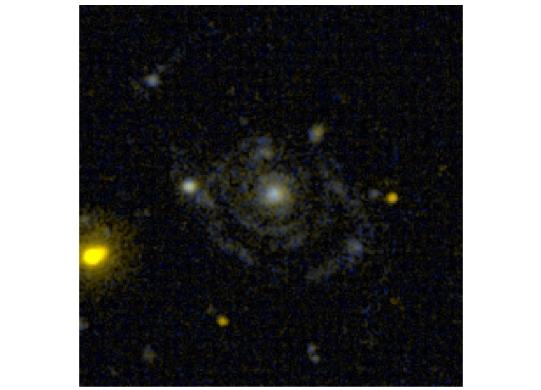
An image of the galaxy Markarian 348 in the ultraviolet. Its active nucleus powers outflowing atomic gas, and new observations of it and four similar galaxies have been able to image the outflow as well as a rotating gas component.
Supermassive black holes at the nuclei of most galaxies, including our Milky Way, develop gradually as material accretes onto the seed black hole. The physical processes that drive this growth – the so-called feeding and feedback processes – occur in the vicinity of the galaxy nucleus. When the accretion becomes active, radiation is emitted that illuminates and ionizes the gas in the vicinity of the nucleus. Accretion disc winds can interact with the gas to produce outflowing gas that is observed to reach velocities of hundreds of km/sec. Relativistic jets of particles emanating from the black hole can also interact with his material. These various kinds of feedback are essential to avoid producing overly massive galaxies.
Clear evidence for all these processes has been detected in their optical emission lines of ionized atoms, whose velocities can be measured. However it has been much hard to obtain spatial information about the geometry of the excited gas. CfA astronomer Martin Elvis and nine colleagues used the Gemini eight-meter telescope and a powerful new instrument that records both high-resolution spatial (as small as a few hundred light-years in size) and velocity information. The team studied five relatively nearby galaxies known to have active black hole nuclei with bright atomic emission. They discovered that in all cases the gas has two major components, one rotating and one outflowing. But otherwise the galaxies are all somewhat different: in one the gas rotates opposite to its stars, in another only one lobe of the outflow can be seen, and there are other differences as well. The new paper is just the first in a series expected to probe and model in detail how nuclear black holes grow.
"Outflows in the Narrow-Line Region of Bright Seyfert Galaxies – I. GMOS-IFU Data," I. C. Freitas, R. A. Riffel, T. Storchi-Bergmann, M. Elvis, A. Robinson, D. M. Crenshaw, N. M. Nagar, D. Lena, H. R. Schmitt, and S. B. Kraemer, MNRAS 476, 2760, 2018.
Related News
CfA Scientists Play Important Role in New NASA Mission
Runaway Stars Reveal Hidden Black Hole In Milky Way’s Nearest Neighbor
CfA Celebrates 25 Years with the Chandra X-ray Observatory
CfA Astronomers Help Find Most Distant Galaxy Using James Webb Space Telescope
Unexpectedly Massive Black Holes Dominate Small Galaxies in the Distant Universe
Distant Stars Spotted for the First Time in the Vast Magellanic Stream
CfA Scientists Help Reach New Milestone in Quest for Distant Galaxies
Astrophysicists Hunt for Second-Closest Supermassive Black Hole
The Tilt in our Stars: The Shape of the Milky Way's Halo of Stars is Realized
JWST Draws Back Curtain on Universe's Early Galaxies
Projects
2MASS Redshift Survey
AstroAI
Dark Energy Spectroscopic Instrument (DESI)
GMACS
For Scientists